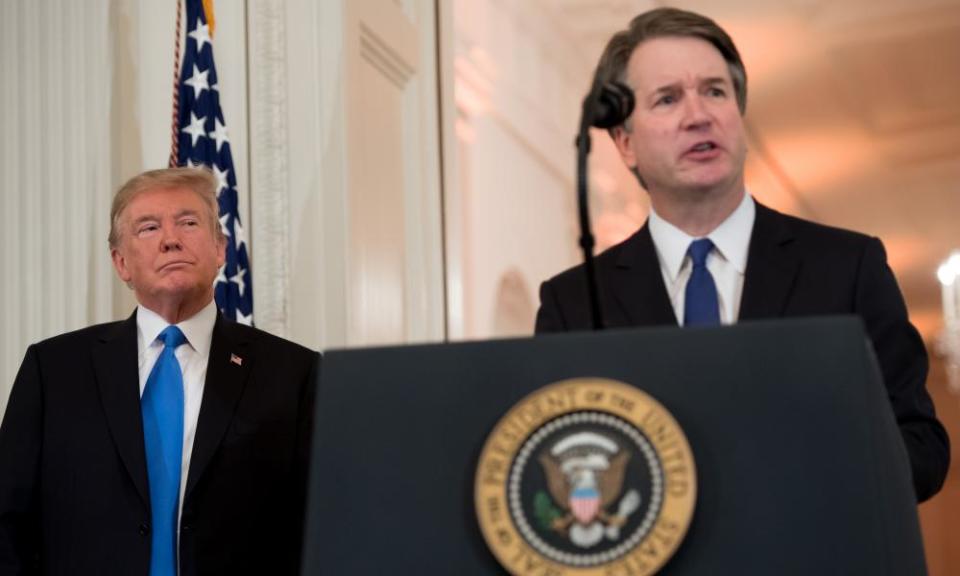Is John Roberts poised to become the supreme court's key swing vote?

Time and again over the past three decades, civil rights campaigns in favor of reproductive choice, LGBTQ equality and affirmative action have crested with thin US supreme court rulings protecting marginalized groups.
That might be about to change. The retirement announcement last month of 81-year-old justice Anthony Kennedy means that the court’s most reliable swing vote – the deciding vote in a number of crucial cases – might stop swinging, legal analysts say, leaving the court’s four liberal-leaning justices to be routinely dominated by a newly strengthened conservative bloc.
Dominated, that is, unless a new swing vote materializes who might occasionally deliver 5-4 victories that American progressives can cheer the way they have cheered landmark rulings clinched by Kennedy on issues such as same-sex marriage and abortion rights.
There is exactly one potential candidate to fill the swing-vote role Kennedy is now vacating, analysts agree. Barring some truly dramatic twist in the intellectual wiring or confirmation prospects of circuit court judge Brett Kavanaugh, Donald Trump’s nominee-in-waiting, that candidate is the sitting chief justice, John Roberts.
Roberts’ claim to the role owes mainly to a pair of relatively recent 5-4 rulings in which the chief justice sided with the court’s liberal-leaning wing to uphold Barack Obama’s health care law. The decisions won Roberts much calumny from conservatives, some of whom cried betrayal.
Roberts sided with the court’s liberal wing once again in the most recent term, in a case protecting the privacy rights of cellphone users in which the chief justice, writing for a 5-4 majority, warned that mobile phone records could “give the government near perfect surveillance and allow it to travel back in time”.
But progressives hoping that Roberts, a George W Bush appointee, Harvard law graduate and Indiana native, will anchor the court somewhere in the ideological center are probably headed for disappointment, experts warned.

Melissa Murray, a professor at New York University specializing in constitutional law, said that Roberts would likely emerge as a fulcrum in some major court decisions, “but not because he is sort of ideologically or legally unpredictable”.
“I think he will be faithfully conservative,” Murray said. “But to the extent there’s any kind of play in the joint, he will be concerned about the court’s reputation and legitimacy, and that might cause him to move in particular directions – but not necessarily because he’s open to any new ideological position. I think he’s still on the right of the court.”
Jay Schweikert, a policy analyst at the conservative Cato Institute thinktank, cautioned that the justices don’t sort simply into ideological blocks.
“I think that there is some truth to the idea that he [Roberts] will be closer to the median justice now, but just given the range of different issues that don’t really break down on a one-dimensional divide, I think that prediction is too general,” said Schweikert.
Geoffrey Stone, a professor at the University of Chicago specializing in first amendment law, said that if Roberts stakes out a new middle for the court, that “middle” will actually be on the right.
“I think Roberts has, in a very few instances, cast votes that departed from the views of other conservatives,” Stone said. “But in the vast majority of the highly influential and controversial cases he has voted with the other conservatives.”
Those cases include landmark rulings on voting rights, campaign finance, public unions and partial-birth abortion, among others.
At times, however, Roberts has led conservatives to question his instincts, which include a preference for narrow decisions that do not seek to take on major constitutional questions the way the court’s conservative lodestar, Justice Clarence Thomas, does not hesitate to do.
Elections have consequences, and Trump has now gotten to nominate two justices who are made in a conservative template
Melissa Murray, NYU
Roberts’ moderating impulse was on display in National Federation of Independent Business v Sebelius (2012), in which the chief justice agreed with the conservatives’ reading of the health care statute but found a creative way, many analysts believe, to side with the more liberal justices.
Roberts also is known to seek consensus on the court, an approach visible in the recent term in Masterpiece Cakeshop, Ltd v Colorado Civil Rights Commission, in which two justices from the court’s liberal wing set aside a free speech debate to agree with the conservative-leaning majority that sincere religious objectors were free to deny goods or services for same-sex weddings.
Stone warned that the imminent confirmation of a second Trump nominee to the court heralded a phase shift in the court’s ideological makeup and a victory that he said conservatives have sought for generations.
“If Kavanaugh is confirmed, they will for the first time have five justices on the court who will adhere to a much more conservative view than has been on the supreme court in living memory,” said Stone.
While only 19% of court rulings in the past two decades have come down to 5-4 rulings, Kennedy participated in some big ones, joining the majority in Obergefell v Hodges (2015), effectively legalizing same-sex marriage nationwide; and Planned Parenthood of Southeastern Pennsylvania v Casey (1992), upholding Roe v Wade.
Those rulings might now be overturned, said Murray, and the swing vote role on the court might simply disappear.
“I don’t think we’re going to see a swing justice in the mold of Kennedy for some time,” she said. “I think that was sort of idiosyncratic, and I don’t think it’s necessary replicable.”
Asked whether progressives’ concerns about a rightward drift on the high court were justified, Murray answered in the affirmative.
“I think it’s obvious the court is going to be lurching toward the right,” she said. “Is that controversial?
“I mean, elections have consequences, and the president has now gotten to nominate two justices who are made in a particular conservative template. And for that reason the court is going to move to the right on a lot of issues.”

 Yahoo News
Yahoo News 
